Belarus is known for its beautiful natural landscapes – lush forests and sparkling lakes, earning it the nickname “the lungs of Europe.” But beyond its natural beauty, this country offers a unique blend of history and culture. You’ll find wide, modern avenues next to charming cobblestone streets.
This country is well known for it’s grand castles, Catholic churches and Orthodox cathedrals, standing tall next to traditional wooden village huts. And don’t forget to experience the hearty Belarusian cuisine! There are more than 300 Belarusian dishes that feature it’s most popular and locally grown ingredient – the potato.
For us, the decision to visit Belarus at this time, was a difficult one. We certainly didn’t want to contribute any money to the Belarusian government given their support of the Putin regime in Russia and against Ukraine. Therefore, we decided to visit the country visa free, making sure that no money was going to the state.
Even though the process is visa free, there are documents that are critical to get prior to entering the country. In addition, there are a few specifics (for example, where you can enter and where you must exit the country) that are listed under the Logistics/Visa section of this post.
Logistics
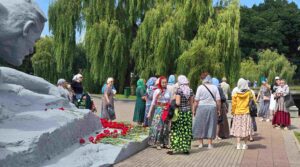
Belarus offers a unique historical and cultural experience, but navigating the logistics is trickier than in most European countries. Here’s a rundown of what to expect and how to plan for your journey here:
BEST TIME TO VISIT
The best time to visit Belarus is in the summer between May – September when the weather is warm and the chance of precipitation is low. Given the political situation in Belarus, we found ourselves to be the only tourists that we could visibly see.
Therefore, if you are looking for an Eastern European destination for the very busy month of August, then this could be a tourist free, visa free solution. The country is also budget travel friendly as long as you stay in apartments (see Accommodation recommendations below).
SAFETY
When we visited and at the time of writing, all travel advisories (Canada, USA, Australia, etc.,) were at the highest level level – Do Not Travel. This is due to the Belarusian authorities’ continued facilitation of Russia’s war against Ukraine, the buildup of Russian military forces in Belarus, the arbitrary enforcement of local laws, the potential of civil unrest and the risk of detention.
The risk of detention was what we were fearing the most. However, given our overall goal of traveling to every country in the world (this is our 192/197 countries visited – the last in Europe) and the thought that things could possibly get worse, we decided to go.
Ultimately, the decision to travel here (or to any other potentially risky travel destination) rests with you and your personal tolerance for risk.
LANGUAGE
Most Belarusian people speak Russian and Belarusian and few speak English. Belarusian, although not as widely used as Russian, is the mother tongue of 53.2% of the population, whereas Russian is the mother tongue of only 41.5%.
If you do not speak Russian or Belarusian, then having Google Translate downloaded (or any other translation app that can be downloaded) is highly recommended.
CURRENCY
The Belarusian ruble (BYN) is the currency in the Republic of Belarus. At time of writing the exchange was $1USD = 3.27 BYN. Some places did take our North American Credit Cards (Visa/Mastercard). However, most did not. Given the sanctions, we could not find an ATM that accepted our North American debit cards.
However, there are exchange booths connected to banks throughout the major cities (Brest, Grodno, Lida) that will exchange $5 USD all the way up to $100 USD at anywhere between $1 USD to 3.15 to 3.18. We could not find a booth that would provide full value exchange (3.27) at the time of writing.
PRO TIP: If you arrive via bus from Poland into Brest, there is an exchange located on the Belarusian side of the border (which was open at 02:00 in the morning). If you are going to be taking a taxi or Yandex to your hotel, then consider exchanging some money here as the drivers do not accept foreign currency.
VISA FREE ENTRANCE

For us, the visa free entrance was the most confusing part of entering the country. Different web sites stated different and confusing/conflicting information and at no point were entry and exit requirements explicit.
If you choose to enter the country by land border and stay only in the western portion of the country, then you may be eligible to enter Visa Free. In addition, if you choose to fly in and out of Minsk (and visit any other cities within the country), then you may also visit Visa Free. There are 72 nationalities allowed such entry including Australia and Canada.
Keep in mind that the United States of America is no longer on the Visa Free list (even though some of the websites still list it as visa free). We do know of one man who was able to enter via bus from Lithuania with a US passport and documents from ZET OOO. However, in our opinion, that would add additional risk to an already risky situation.
Even though you may enter the country visa free, there are a number of documents that you must have printed prior to entering Belarus. There are a few travel agencies that provide these documents. However, the most popular of these: ZET OOO stopped communicating with me after weeks of emails.
We ended up using bezviz.by , an organization from Poland which provided us the Visa Free document (with the crucial bar codes), medical insurance (you need this even if you already have medical insurance) along with some “excursions” which were prepaid entrances to various museums (you must purchase these through this program). The cost per person was $50 USD (All Western Belarus) and our documents arrived in our email box within 5 minutes of payment.
Keep in mind, if you enter/exit via a land border, you have 2 options of areas to visit. There is the cheaper area near the border with EU or the all Western Belarus (which is what we chose). This includes Mir Castle. There is a better map here to see the borders of the 2 options.

CONNECTIVITY: SIM/ESIM CARDS
We purchased an MTS SIM card from a strip mall located near our hotel in Brest. Other malls with cell phone stores offered similar services. This SIM card offered unlimited data and a phone number for 4 weeks of use within the country. The cost was $7.64 USD.
ACCOMMODATIONS
Securing accommodations in Belarusian cities is not straight forward, as our go to websites like booking.com, Airbnb, hotels.com, etc., just do not work (even with a VPN) due to sanctions. Below please find some sights that do work:
- Ostrovok.ru is a Russian site that you can use to book Belarusian accommodations that include hotels and apartments. The site will work to prebook prior to arrival.
- kvartirka.by which acts like an Airbnb for Belarus
- kufar.by this site will work when you are in Belarus
- Euapartments.by these are luxury apartments in Grodno and Minsk. Our apartment in Grodno was high end luxury for $55 USD per night.
TRANSPORTATION
There are a few options for transportation throughout the country. If you are entering Visa Free, then renting a car is prohibited. Here are some options that you can choose from depending on your style of travel. Keep in mind, that we were told that we would not be able to purchase train or bus tickets because we are foreigners. Therefore we chose to travel with drivers that we recommend below.
Trains:
- Limited Network: Belarus’ railway system is not as extensive as most European countries. It primarily connects major cities like Grodno, Lida, Brest with Minsk.
- Information and Booking: Check the train that you are looking for here (in Russian or Belarusian). You can also visit the train station where they will most likely only speak Russian.
Taxis and Rideshare:
- Readily Available: Taxis are a convenient option for getting around cities like Brest, Grodno and Lida.
- Negotiate Fares: It’s customary to negotiate a fare with the taxi driver before your journey.
- Ridesharing App: Yandex is the only ride-sharing app in the country. Most of these cars double as taxis. It requires a local phone number which you will receive with your SIM card.
Buses and Marshrutkas:
- Extensive Network: This country has a network of buses and minibuses called “marshrutkas.” These connect cities, towns, and some villages, offering a budget-friendly way to travel.
- Purchasing Tickets: Tickets can be purchased from the kiosk inside of the bus terminal. However for marshrutkas, tickets are typically purchased directly from the driver on board of the small bus.
- Limited Schedules: Be aware that some routes, especially in rural areas, may have limited schedules. Research timetables beforehand if possible, or ask locals for guidance.
Drivers:
- Andrei Popov What’s App + 375 29 589 22 12. Andrei’s rates are the following: 100 BYN per day + tank of gas 95 BYN. This will provide 500 km of driving from his home (Andrei is based about 100 km south of Mir) to you and then back to his home. Every additional 100 km is 17 BYN. Andrei picked us up from Brest and drove through the castles leading to Mir Castle. Then from Mir Castle to our apartment in Grodno. The day was a long one and all in was $90 USD (which included a generous tip). We could not have done this with buses in one day. Andrei is a careful driver and is a lovely man who speaks perfect English and Dutch as he is also a translator. The car is basic but comfortable, however, does not have air conditioning.
- Victor What’s App + 375 44 458 26 97. Victor is a taxi/Yandex driver in Grodno. Victor arranged for a driver to pick us up from our apartment in Grodno and take us to the Lida bus station in a modern air conditioned car. The overall cost was 150 BYN with a good tip which is approximately $47 USD. Victor nor the driver speak English.
Day 1- Entering Visa Free

Upon entering the bus at the Chopin Airport Bus terminal, the bus driver who only spoke Russian, interrogated me as to why I did not have a visa. I calmly explained and showed him our documents. He was finally satisfied and quickly said, ” You do have tickets to exit the country through Latvia, right? Poland will not welcome you back through this entrance again!” I showed him our bus tickets out and he seemed satisfied. Looking up at me, he continued, “You do know that there is a percentage of people that they just do not let in, right?!”
Our bus took us from Warsaw to the town of Terespol on the Belarusian border in just 3 hours. As the bus did not have a toilet, everyone piled out to run to the paid toilet inside a cafe. The bus driver warned us, that this will take some time. Hours passed and the cafe with it’s toilet shut down. Many people would pass by the bus and ask the drivers if they could purchase a spot just to cross the border. The answer was always an emphatic no. After about 5.5 hours, our bus was allowed to enter the Poland/Euro stamping out zone. This took about 45 minutes.
We waited another 45 minutes or so and the bus drove over a long bridge entering Belarus border control area. We entered the stamping in hall. After some confusion, we were stamped in. The border control agent said, “If you stay longer than 10 days you must register yourselves”. We lined up to have our luggage thumbed through. That agent wanted to know how much we had in foreign currency “valuta”. I responded, noting that a sign said that $10K USD was allowed per person. There was a small exchange booth, where we exchanged $20 USD to BYN.
Exhaling we got back on the bus. Another 1.5 hours passed. The bus drivers finally returned. They murmured to each other solemnly…minus 8. I was trying to understand what was happening. When we were exiting Poland we had 44 passengers on the bus plus the 2 drivers, 46. This number kept on being repeated by each border control person, military person, etc., that would get on the bus and count and recount people.
We had 46, but now we had minus 8, therefore 38. The bus drivers kept on trying to figure out why the people disappeared, where they went and what happened to them. The mood on the bus became quite somber. We drove another 20 minutes and ended up in the Brest Main Bus Station. It was after 04:00 in the morning. This process took over 11 hours, but we were happy to climb in the cab and go to our hotel – Hampton Inn by Hilton Brest.
Day 2 – Brest

When we finally woke up, breakfast had long passed and we made our way to the nearby mall to get some money exchanged, a SIM card and some food. What is great about this city, is that there is always a store or a mall around the corner, so we didn’t go hungry for long.
Brest, might look like a brand new city built in the 20th century, but don’t be fooled! This city has a much older story to tell. In fact, Brest was first mentioned in records dating all the way back to 1019, making it one of the oldest cities in the area. We spent the day exploring these areas of the city:
Brest Fortress

Built in the early 1800s, Brest Fortress is a star-shaped fort with a rich history. It played a crucial role in World War II, becoming the first battleground of the Eastern Front when it defended against the Nazi invasion in 1941. Today, the restored pieces of the fortress offer a moving and immersive experience. However, don’t expect a fortress like we did – this is a park with some remnants of a fortification and 20th century mostly Soviet era monuments.
Visitors can walk through the star-shaped gate and be transported back in time by the haunting sounds of the war. Explore the grounds, museums, and the “Courage” sculpture – a giant monument to the soldiers who fought during World War II. Don’t miss the beautiful hidden gem, an old Orthodox church, located just behind the sculpture. While the Brest Fortress is a must-see sight, the city itself has even more to offer than you might expect.
Train Museum
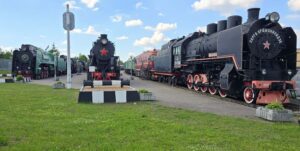
If you’re a train buff like Rob, then the Brest Railway Museum, located not far from the famous Fortress, is a fun place to visit. Opened in 2002, this open-air museum is the first of its kind in the country. Stepping onto the grounds feels like stepping back in time. There are around 60 immaculately maintained exhibits. Most are steam locomotives and vintage passenger cars, all gleaming in the sunlight.
Some of the grander locomotives display portraits of Lenin or Dzerzhinsky on their fronts. But the real treat for any train enthusiast is the chance to climb aboard some of these trains. You can explore the cabins and see all the intricate details firsthand. It’s a truly unique experience.
Please note that this museum is closed on Mondays and Tuesdays. Wednesdays through Sundays it operates from 11:00 to 20:00.
Sovietskaya Street
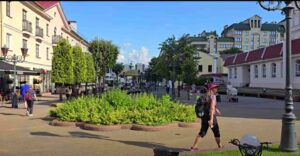
Brest’s main pedestrian street, Sovietskaya, is a lovely stroll. This vibrant street is packed with cafes, restaurants, and shops, making it the perfect place to grab a bite to eat, relax, and people-watch.
During our visit, the street buzzed with activity. As you walk down Sovietskaya, keep an eye out for the quirky sculptures scattered around and the charming gas lamps. Notably, Brest is one of the last European cities to still use gas lamps, and each day a lamplighter, dressed in old-fashioned garb, lights them up around dusk (you can even find a clock on Sovietskaya indicating the time he begins his nightly ritual!).
Another point of interest at the corner of Sovietskaya and Budyonny Streets is the Cinema Belarus building. While it stands out as an interesting example of Soviet architecture, its history is more complex. The cinema was actually built on the site of the former central synagogue.
Brest, like many cities in the region, had a significant Jewish community. However, World War II tragically changed this. The central synagogue was severely damaged during the war, leaving only its round foundation. This foundation served as the base for the round-shaped Cinema Belarus which was built in the 1970s. Sadly, there’s not much of the original foundation visible today, but the building remains a point of historical interest.
Don’t miss the Millennium Monument of Brest either, located at the corner of Sovietskaya and Gogol Streets. Erected in 2009 to celebrate the city’s 1000th anniversary, the monument showcases the history of Brest, featuring important figures who have played a role in shaping the city’s past.
Where to Eat in Brest
Jules Verne: If you want to treat yourself, then Jules Verne is a nice cafe to check out. Maybe try, a Halibut with Oyster Sauce and Clams for about $12 USD. Being vegan, I chose 2 side dishes. One with the grilled vegetables with another side of roasted potatoes. Both plates did not break the bank at $5 USD for both.
Traktir “U Ozera”: For some good ole Slavic food, this is a down to earth place. The name directly translates – tractor on the lake. Our recommendation is to try some pelmeni (dumplings) and or vareniki (mostly sweet dumplings in the shape of a crescent) here. The prices for these dishes here average $2 – $3 USD. Although other dishes can be pricier.
Day 3 – Kosava Palace, Nesvizh Castle and Mir Castle
On our 3rd day, we sampled the delicious and varied breakfast of the Hilton, packed up and met our wonderful guide/driver Andrei. In retrospect, we should have departed the hotel around 09:00, however we were lazy after the long bus adventure the night before and asked Andrei to pick us up at 10:30.
Kosava Palace

Our first stop was Kosava Palace, a newly renovated structure set in the Belarusian countryside. It is a dreamlike structure which has many names – the Puslovsky Palace and also known as Kossovo Castle. Built in the 19th century, it’s a stunning example of Neo-Gothic architecture, and its fairy tale-like appearance has earned it the nickname “knights’ dream.”
The palace wasn’t just beautiful; it was grand. Surrounding it was a magnificent park with over 150 types of exotic plants! A special greenhouse was even built to house the most delicate specimens. The park itself was a masterpiece, with cascading terraces leading down to three man-made lakes and ultimately connecting to the Kosciuszko estate.
Sadly, the Puslovsky family’s ownership wasn’t meant to last. After losing the estate in a gamble, Kosava changed hands several times. The early 20th century saw the palace serving as a district administration office and a beekeeping school.
However, World War I and World War II brought devastation. During WWI, the palace was looted, and its valuables were stolen and taken abroad. World War II inflicted even greater damage. A fire raged through the palace in 1944, destroying the interior decorations and leaving only the magnificent walls standing.
Despite its troubled past, Kosava Palace remains an interesting landmark. Local legends even add to its mystique. Stories abound of the owners keeping a lion as a guard, roaming the corridors at night to protect the place.
Nesvizh Castle
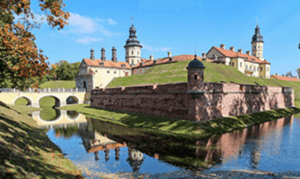
Driving further north, we got to Nesvizh Castle. Nesvizh Castle was built in the 16th century and is a UNESC World Heritage site. It was the home of the powerful Radziwiłł family. It wasn’t just a residence, but also a strategically important fortress and a center of culture and politics. The castle witnessed many historical events and became a symbol of Belarusian identity, especially during the Soviet era.
The Nesvizh castle is an example of Renaissance architecture with a mix of styles. Its grandeur is evident in the decorated facade, elegant towers, and beautiful gardens. Inside, the castle are lavish halls with frescoes, luxurious furniture, and a vast art collection. Visitors can explore various rooms, including a grand ballroom, a golden hall, and a well-stocked library.
The beauty extends beyond the castle walls. Meticulously landscaped gardens with vibrant flowers, water features, and hedges surround the castle. The vast parkland offers a peaceful escape with lush greenery, walking paths, and picnic spots.
Like many old castles, Nesvizh has its share of secrets and legends. One story involves the “Lady,” a ghost said to haunt the building’s many halls. The castle also has hidden underground passages used as escape routes and for secret meetings.
Mir Castle
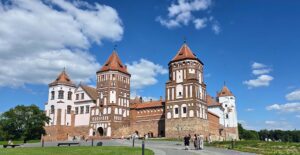
The Mir Castle Complex (a UNESCO World Hertiage Site) is one of the most striking fortifications in the country. The castle has a unique blend of architectural styles which include Gothic, Baroque, and Renaissance. Built in the 16th century, the castle began as a Gothic fortress under Duke Ilinich. Later, in the 1560s, the Radziwiłł family acquired the castle and transformed it into a Renaissance masterpiece.
During their ownership, the Radziwiłłs added a three-story palace with lavish rooms, fortified the castle with earth walls and a moat, and created beautiful gardens on the grounds. An Italian garden graced the north side, while an artificial lake added tranquility to the south.
The castle faced hardships during the Napoleonic Wars, suffering significant damage. However, it found new life in the late 19th century when the Svyatopolk-Mirsky family purchased it and began restoration efforts.
After extensive restorations, the castle reopened to the public in 2010. Further refurbishment efforts are ongoing to preserve the Italian Renaissance Park, English Park, pond, and the Svyatopolk-Mirsky Castle itself.
After sampling some very late lunch in the parking lot cafes of Mir Castle (there are quite a few of them), we departed heading to our apartment in Grodno where we decided to spend 3 nights.
PRO TIP: If you are short on time and need to pick only 2 of the 3 castles, we would recommend choosing Nesvizh and Mir. If you can only visit one, then choose Mir Castle.
Day 4 – Grodno

Our apartment in Grodno (where we spent 3 nights) was through the Euapartments.by site. The apartment was truly luxurious and central – we cannot recommend this organization enough! Honestly we did not want to leave after 3 nights here.
For our first day in Grodno we decided to visit the Old and New Castles of Grodno, and stroll Sovietskaya Street – a walking open air museum of the city.
Old Castle Grodno
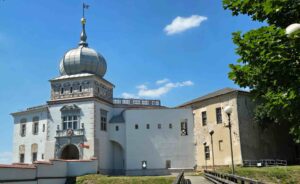
The Old Castle of Grodno is a historical complex that tells the story of how a fortification like this castle gets built over centuries. Its origins date back to the 11th century, when a wooden fortress stood guard. After a fire ravaged the structure in the late 14th century, Grand Duke Vytautas the Great rebuilt it in Gothic style, adding five imposing towers. This “Upper Castle” later became known as the Old Castle.
The castle’s strategic location atop a steep hill overlooking the Neman River added to its defensive prowess. The formidable walls stretched nearly 300 meters long, with an average thickness of 3 meters, making it a powerful stronghold.
During the 16th century, the Old Castle witnessed a period of grandeur as it served as the residence of King Stefan Batory. However, the tides turned during the Northern War in the early 18th century. Swedish forces inflicted significant damage to the castle, leaving only remnants standing.
Despite the destruction, the Old Castle persevered. Today, visitors can explore the surviving elements, including the Palace, defensive wall fragments, the prince’s quarters, the bridge, and the overall castle site. In 1925, a museum dedicated to history and archaeology was established within the castle walls, further enriching the experience for visitors.
New Castle Grodno

The Old Castle of Grodno wasn’t the only royal residence in town. The Great Northern War in the early 18th century left it in ruins. Faced with a damaged castle, instead of repairing it, a new project began – the New Castle.
Construction started in the early 1700s and took a significant 50 years to complete, with project finally being completed in 1789. This grand new palace served a dual purpose: it housed the Polish General Sejm (parliament) and provided a residence for Polish kings.
However, Grodno’s fate changed at the end of the 18th century. The city became part of the Russian Empire. Before World War I, a new vision emerged. Emperor Nicholas II decreed Grodno’s transformation into a powerful fortress. This involved the construction of several forts and fortifications around the city. The New Castle wasn’t spared this change. Its royal past was put aside as it was adapted for military use, becoming barracks.
Sadly, World War II brought further devastation. The New Castle suffered destruction during the conflict. When the complex was restored in the mid-20th century, its former grandeur was lost. The Soviet influence was evident in the architectural style, with buildings taking on some features of the Soviet Empire. Even the main tower’s spire was redesigned, topped with a symbolic five-pointed star.
The New Castle of Grodno’s story reflects the city’s own tumultuous history. It began as a royal residence, transitioned to a military site, and ultimately underwent a transformation that reflected the changing political landscape.
Sovietskaya Street Grodno
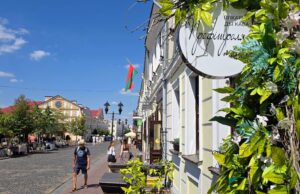
Sovietskaya Street, also sometimes referred to as Sovetskaya pedestrian street or Sovetskaya walking street, is a vibrant pedestrian zone in the heart of Grodno. Considered the city’s “most beautiful walking street”, it’s a popular destination for both locals and tourists. However, the only tourists that we got to see were us!
This charming car-free zone has a rich history. While the street’s name translates to “Soviet,” its origins date back much further. The area was once the center of Grodno’s marketplace, and the street itself has undergone various transformations throughout the centuries.
Today, Sovietskaya Street is a feast for the senses. Lined with colorful buildings in a variety of architectural styles, it offers a glimpse into Grodno’s architectural heritage. Strolling down the street, we met a lot of local artisans selling their handmade goods. There are also shops selling souvenirs and local crafts, cafes with inviting outdoor seating, and street performers adding to the lively atmosphere. In addition, there are well-preserved historical buildings lining the street for added charm.
Beyond the shops and cafes, Sovietskaya Street offers a tranquil escape. Lush greenery and strategically placed benches create a relaxing environment, perfect for people-watching or simply enjoying a break. A public square with the iconic “I love you, Belarus!” sign provides another opportunity to soak in the atmosphere.
Where to Eat in Grodno

Doppio (Kofeynya Doppio) is a great central place to grab a coffee (and yes they have oat, almond and soy milk) and some lunch. The atmosphere is super relaxed and the restaurant has vegan and vegetarian options. Their vegan deserts are amazing and even impressed Rob.
Restaurant Bakst is an upscale restaurant with many options of seafood, steaks and chicken. Main dishes are around $10 – $12 USD. For vegans and vegetarians there is the staple grilled vegetables and potatoes for around $5 USD for both.
Houdini is a funky gastropub with fusion seafood. Try the Salmon Tartare with Avocado or Poke with tuna, salmon and shrimp. Each dish was about $7 USD. There are also meat dishes: Steak and Potatoes and fowl dishes: Teriyaki Duck Leg with cranberry sauce. Each dish is under $10 USD.
Day 5 – Grodno
During our second day in Grodno we continued to explore the following areas:
Kolozha Church
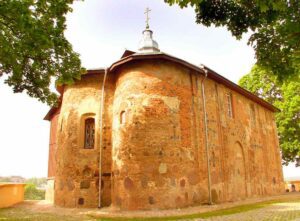
The Kolozha Church (also known as St. Boris and Gleb Church) is the oldest building in the city and one of the rarest examples of Black Ruthenian architecture. Built before 1183, the church is famous for its colorful, decorative stones and unique design. Despite its age, the church is still in use today and is a significant cultural landmark for Grodno.
The Great Synagogue
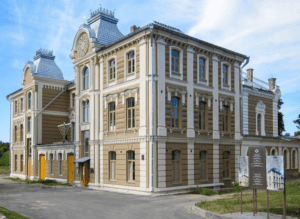
The Great Synagogue, also known as Bolshaya Sinagoga, stands as a powerful symbol of Grodno’s past religious diversity. Built between 1902 and 1905, the Moorish-style building has a stunning interior. Imagine a vast, airy space bathed in pure white – a striking contrast to the synagogue’s ornate exterior.
Today, the synagogue houses a small museum dedicated to the Jewish history of Grodno, offering visitors a glimpse into the vibrant community that once thrived here.
Park Zhilibera
Located in the heart of Grodno, Park Zhilibera offers a mix of greenery and entertainment. Featuring a central Soviet War memorial, the park serves as a place for quiet reflection. But it’s not all solemnity! Park Zhilibera also comes alive with fun fairs and markets, providing a lively atmosphere.
The park’s charm extends to its riverside location, creating a peaceful environment perfect for a leisurely stroll. Several cafes and cozy bars with inviting beer gardens dot the landscape, making it a great spot to relax and socialize.
Holy Intercession Cathedral
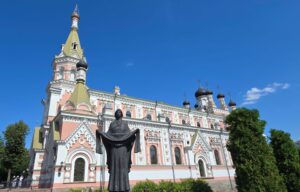
The Holy Intercession Cathedral is a unique landmark that has stood strong through difficult times. Built in the early 1900s, it honors the memory of soldiers and officers lost in the Russo-Japanese War. Despite facing challenges during the German occupation and Soviet era, the cathedral has remained a functioning place of worship.
Architecturally, the Holy Intercession Cathedral is a beauty. Its “pseudo-Russian” style features detailed entrance portals and windows, creating a visually striking design.
Kalozski Park
Kaložski Park, is a haven for those seeking peace and natural beauty. This serene green space provides a welcome escape from the city’s bustle. Stroll along the park’s paths and immerse yourself in its tranquility, or take a leisurely bike ride while enjoying the fresh air.
History buffs will appreciate the presence of centuries-old churches and monuments scattered throughout the park. These landmarks add a layer of cultural significance to your visit and provide picturesque backdrops for photography enthusiasts.
The park is particularly charming due to its well-maintained grounds and scenic location. Lush greenery and the proximity to nearby rivers create a picturesque setting that is perfect for relaxation. Whether you’re looking for a quiet place to unwind or a historical site to explore, Kaložski Park offers a delightful experience for visitors of all interests.
St. Francis Xavier Cathedral
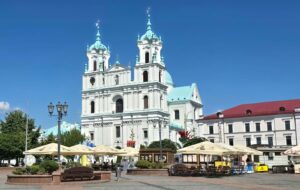
The St. Francis Xavier Cathedral, is a magnificent landmark with a rich history. Originally built as a Jesuit church between 1678 and 1703, it wasn’t just a place of worship but also a center of education and culture. The impressive structure was designed in the Baroque architectural style, known for its grandeur and intricate details. We were lucky to watch a wedding in this cathedral during our visit.
The cathedral’s history reflects the changing times of Grodno. It served as the main church for the city and even the residence of the Bishop in the 18th century. However, during the Soviet era, the church was closed for religious services and repurposed as a museum. Despite this period of secular use, the church persevered and was eventually returned to the Catholic Church in 1988.
Today, St. Francis Xavier Cathedral stands tall as a functioning cathedral and a significant historical landmark. Visitors can marvel at its imposing facade adorned with two elegant towers. Stepping inside reveals an interior showcasing the opulence of Baroque design.
The Prison Next to St. Francis Xavier Cathedral
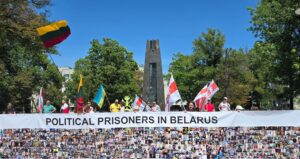 A demonstration in Vilnius to support the release of the Belarusian political prisoners.
A demonstration in Vilnius to support the release of the Belarusian political prisoners.
The St. Francis Xavier Cathedral stands in a powerful contrast to its neighbor – a large, white-walled prison. The prison, currently houses 74 political prisoners, making up about 5% of the country’s total.
When you are near the cathedral, look up. There are 2 angels “standing” next to the crosses on top of the 2 towers of the church. For some of the political prisoners these angels are the only glimpse of the free world that they can see.
Lyamus House

Lyamus House holds the title of the oldest surviving wooden building in the country. Construction is believed to have been completed in 1630, making it a true architectural marvel. This two-story house is unique for its use of traditional techniques – built entirely without nails!
While visiting the Lyamus house, you’ll also notice interesting architectural details like the loggia on the second floor and the small gallery on the first, showing how the rooms would have looked in the past. The property was originally located on the grounds of the Brigitte Monastery where it remains today. In effect, the Monastery had to buy their own property back from the government, rescuing the beautiful grounds (where they also keep a small vegetable garden).
Day 6 – Lida
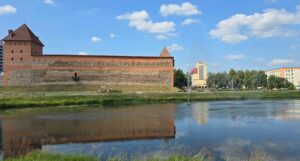
It was difficult to leave our gorgeous apartment in Grodno. Our driver picked us up at 12:00 and we were whisked off to Lida where we were dropped off at the Lida Hotel (one of only 2 hotels in the city). There isn’t that much to do in this city, so we were happy to be located next to the Lida Castle.
Lida Castle
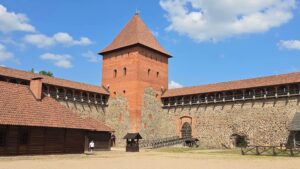
Lida Castle, has a rich history dating back to the early 14th century. Built by Grand Duke Gediminas of Lithuania, it served as a crucial part of the country’s defensive chain against the Teutonic Knights. The castle’s strategic location at the confluence of the Lida and Kamenka rivers further enhanced its defensive capabilities.
Constructed from boulder walls that were later faced with red brick, Lida Castle stands as a testament to medieval engineering. The castle witnessed many historical events throughout the centuries. It was besieged, ravaged by fire, and even used as a courthouse at various points in time.
Despite facing significant damage, Lida Castle has persevered. Today, the castle complex includes the main castle building, two towers, and the surrounding grounds. While some of the original structures are no longer standing, the remaining parts have been restored. Visitors can explore the castle walls and towers, and even participate in interactive experiences that bring the medieval era to life.
One of these historical re-enactments is the 15th century wedding of Sophia of Halshany and King Jagiello. King Jagiello, a widower with no sons, was already 73 when he met the Halshany daughters during a visit. According to legend, he was captivated by the younger Sophia, hoping she would give him an heir.
After swift negotiations, the king married the 16-year-old princess. While the official wedding ceremony was held in Novogrudok, the newlyweds stopped at Lida Castle on their way to Krakow for the coronation.
The re-enactment at Lida Castle brings this historical event to life. Interestingly, history records do show that Queen Sophia indeed gave birth to three sons, securing the future of that dynasty.
Church of the Exaltation of the Holy Cross
Lida Castle isn’t the only historic landmark in town. Right next door, on Grunwald Street, visitors can find the oldest church in the city – the Church of the Exaltation of the Holy Cross.
This church’s history is a story of perseverance. Chronicles tell of the first church being built in 1388 only to be destroyed by crusaders. Several attempts to rebuild with wood followed, but these churches also succumbed to fire. Finally, in 1765-1770, a more permanent solution emerged – a stone Church of the Exaltation of the Holy Cross.
The architect was Johann Christoph Glaubitz, a renowned figure who played a key role in shaping the Vilna Baroque style. The original design had a three-aisled basilica layout with two matching bell towers. Sadly, these towers were lost to fires during wars, and the brick fence surrounding the church also fell victim to time.
Despite these setbacks, the church persevered. Visitors today can still marvel at the beautifully frescoed vaults and walls. Stepping inside reveals an interior adorned with ornamental molding and Rococo sculptures, adding to the church’s grandeur.
A particularly significant treasure within the church is the icon of the Mother of God with the Child. This revered piece is believed to have been brought to Lida by Franciscan missionaries back in the 14th century, further solidifying this church’s long and rich history.
Lida Main Park
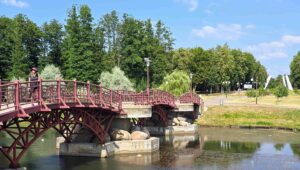
Oddly, the main park in the city of Lida does not have a name – it is just called Park. This green space was my favorite place in the city to stroll and unwind. There are many cute walking bridges over the Lidzeyuka River here, where couples leave heart shaped locks to commemorate their relationships.
There are also fountains, monuments and the eternal flame along with the Lida City Palace of Culture bordering the property.
Where to Eat in Lida
This city is quite small – one can legitimately call Lida a town. Therefore there aren’t too many places to eat. Here are some suggestions:
Brew pub – Lidskaje Piva is a typical brew pub. The thing to eat here is the Golenka (chicken leg) with roasted potatoes. If you are vegan, then the potatoes will have to do. There is also cold beer and other beverages here.
PizzBurg is a modern cafe serving pizza and very large burgers which you can either eat with plastic gloves (which are offered) or with a fork and a knife. If you don’t like your burger smothered in sauce, then we suggest you ask for the sauce to be on the side. A huge grilled chicken burger is about $3 USD and a beer around $1.50 USD.
Wrap Up

Even though we have traveled to a lot of risky countries, Belarus is the one that freaked me out the most. Even writing this post caused me quite a bit of anxiety. I keep on remembering the bus drivers returning to the bus and murmuring…minus 8….We will never know what happened to those people.
Bottom line, Belarus is an interesting country with some sights to see. With our Belarus Visa Free documents we only saw the west and not the east or the capital Minsk. Therefore it is difficult to comment overall. However, in the grand scheme of things, was it worth the risk or would we have been better off just visiting Moldova?
My short answer is, unless you are trying to visit every country in the world, go to Moldova and or maybe to Bulgaria, Latvia, Estonia, Lithuania, etc., Enjoy the freedoms that these countries still have, as that may also change….
Have you been to any of these Eastern European countries? What was your take? We would love to hear from you in the comments.

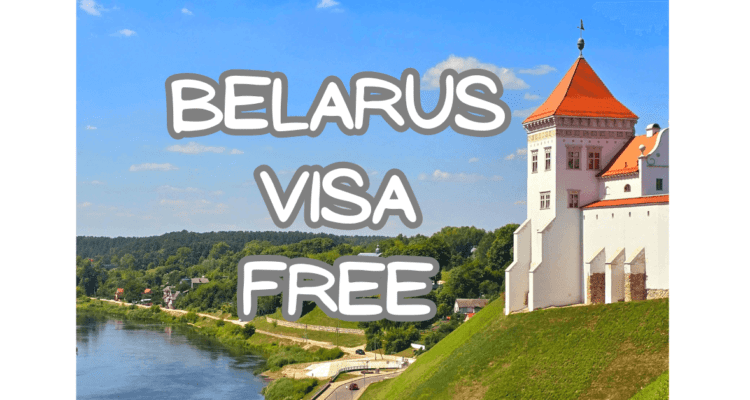
2 Comments
Do you need visa if you from Europe
Hello, Dean! Depends where in Europe, but most likely you can do it Visa Free. However, you still need a document from a company like bezviz. Check out this site: https://bezviz.by/en/ as they provided us with all the information. Their What’s App listed on their page also works to have a conversation (although it took them 10 days to respond the first time).